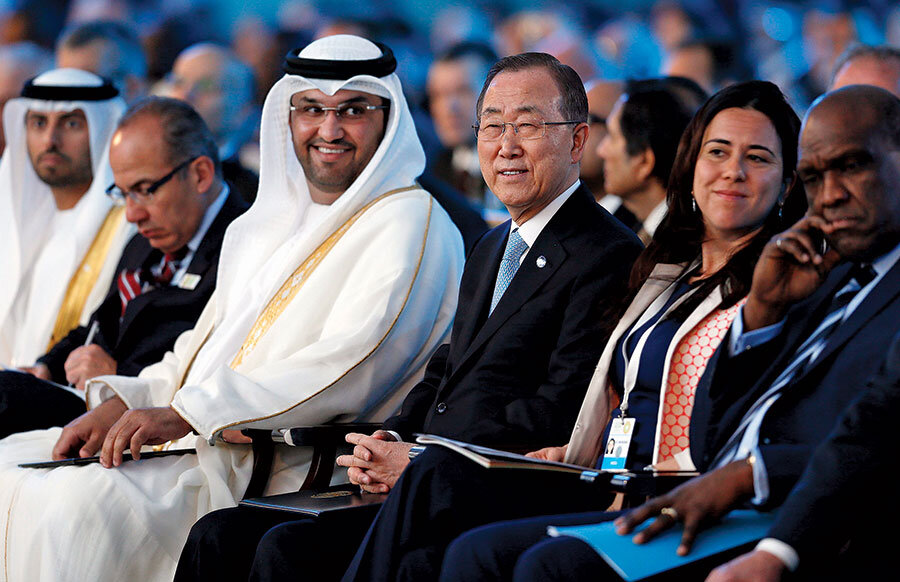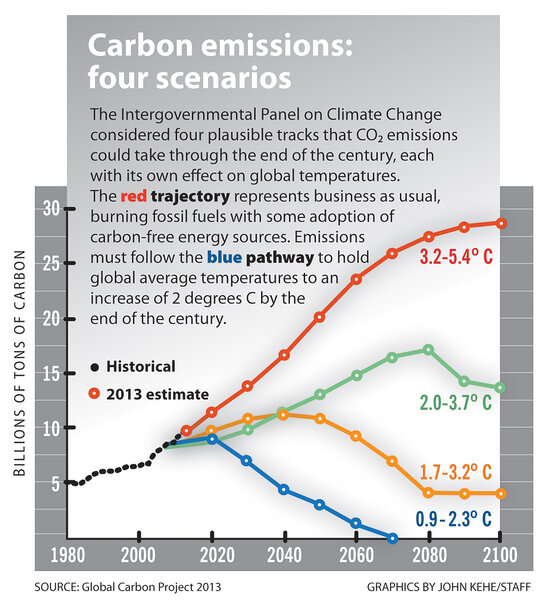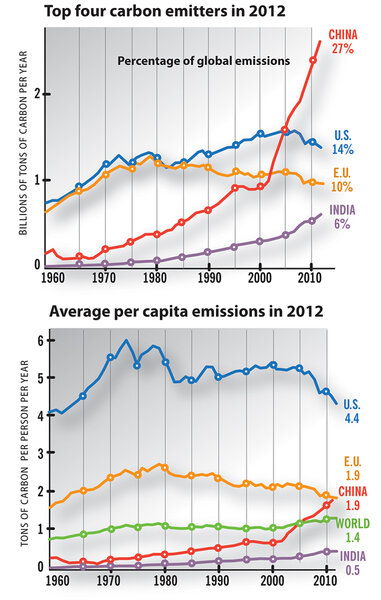Global warming: Can post-Kyoto climate pact work by taking a different tack?
Loading...
The history of international efforts to rein in global warming is littered with a forest of printed reports, talking points, and treaty drafts – all in pursuit of two agreements that lacked either rigorous enforcement or the participation of key signatories.
Along the way, countries found common ground on some issues. But negotiations also were arduous and ripe with finger-pointing. They pitted the industrialized world against developing countries, oil-producing nations against their biggest customers, even developing countries against segments of their own indigenous populations.
At issue were questions of historical versus shared responsibility for greenhouse-gas emissions and a fair distribution of the costs and benefits from taking part in a global climate regime.
Meanwhile, carbon emissions have soared, and Earth’s climate, as measured by observed temperatures, rising sea levels, receding glaciers, and disappearing polar ice, has continued to warm.
Perhaps the third time will be the charm.
Negotiators who met this month are working on a new global climate pact, one that hopes to build on the lessons learned from its predecessors: the 1992 United Nations Framework Convention on Climate Change (UNFCCC) and the 1997 Kyoto Protocol, set to expire in 2020. The agreement currently being negotiated is expected to take effect then and set the tone for emissions reductions through 2030 and beyond.
Architects of the new pact are looking for ways to set the world’s economies on a path toward zero net greenhouse-gas emissions in the second half of this century. Their approach this time: no mandates for economy-wide emissions cuts; no torturous, drawn-out ratification processes; and peer pressure – at least initially – as a key enforcer.
Instead, countries would specify their own paths and pledge to follow them – paths informed by a goal of trying to hold global warming to an average of 2 degrees Celsius above preindustrial temperatures by century’s end. By 2009, countries acknowledged that this target would avoid what the 1992 UNFCCC agreement dubs “dangerous” human “interference” with the climate.
As a bridge to 2020 for countries that aren’t participating in the Kyoto Protocol, negotiators also are looking for ways to coax more emissions reductions from nations that made voluntary commitments in 2009 as the UNFCCC’s climate summit in Copenhagen, Denmark, drew to an acrimonious end.
Countries are taking steps on emissions that are carrying them in the right direction, says Christiana Figueres, the UNFCCC executive secretary.
But, she adds, “we don’t have the right pace and we certainly don’t have the right level of effort” needed to put the work on the 2-degree path.
It’s a path in which global greenhouse-gas emissions must peak in six years and begin to decline, according to the latest set of climate reports from the Intergovernmental Panel on Climate Change (IPCC).
Yet emissions currently are following a robust “business as usual” path despite previous agreements, and are already higher than the desired 2020 peak, according to the Global Carbon Project, which tracks emissions trends.
For some longtime observers, the new approach carries more than its share of déjà vu. In some ways, it harks back to the ’92 agreement’s initial, you-pledge-we’ll-watch scheme.
By 1995, however, countries deemed that approach inadequate in the face of rising emissions. This led to the Kyoto Protocol, with its legally binding emissions targets and timetables for achieving them.
Kyoto was to lay the foundation for a series of stepwise reductions in emissions among industrial countries. But it lacked a key player: the United States, which withdrew from the protocol in 2001.
Past 20 years was ‘a round of experiments’
More recently, Canada also withdrew. Japan, Russia, and New Zealand had binding targets under the protocol’s initial 2008-12 emission-control period but have no binding targets in the current and final control period.
Today, the countries with binding targets account for only about 13 to 14 percent of global greenhouse-gas emissions.
The shift toward allowing countries to set their own emissions goals, and the use of peer pressure to enforce them, are explicit acknowledgments that politics and hands-on experience in curbing emissions within a country will determine how ambitious that country is in setting its goals at the negotiating table, analysts say.
“In a way, you can look at the last 20 years as a round of experiments,” says Elliot Diringer, executive vice president of the Center for Climate and Energy Solutions in Arlington, Va.
Countries experimented with the bottom-up and top-down approaches, learned the strengths and weaknesses of each, and now are trying to come up with a blend that “hopefully captures the best of both,” he says.
Now, the goal is to negotiate a draft pact by the end of this year and have it ready for countries to sign by the end of 2015, according to the UNFCCC’s Ms. Figueres.
“It’s a short timeline,” she acknowledges, one driven by the emissions trajectory the IPCC identified as having the best chance of achieving the 2-degree goal, the only one “that is morally acceptable for any of us to work toward.”
Part of what gives her hope, Figueres says, is that many countries have undertaken a good deal of legal spadework over the past five years. By the end of 2009, some 40 climate-related laws were on the books globally, she says. Today, 60 countries accounting for some 80 percent of global emissions collectively have 500 laws on the books focusing on climate change mitigation in some way.
At interim climate talks in Bonn, Germany, June 4-15, negotiators sought ways to increase the voluntary emissions-control commitments that countries made at global climate talks in Copenhagen.
Progress was made in enabling the spread of technologies that can help cities reduce emissions, as well as the sharing of beneficial farming and forestry practices, notes Alden Meyer, director of strategy and planning for the Cambridge, Mass.-based Union of Concerned Scientists, which focuses on climate, sustainable development, and national security issues. The hope is that these interim sessions will lead some countries to tighten their emissions policies through 2020 via an agreement at the UNFCCC’s climate summit in Lima, Peru, at the end of this year.
But on the main track – an agreement that covers 2020 and beyond – difficult questions remain:
• Will all countries submit their home-grown emissions plans in time for other countries to review, comment on, or even twist arms a bit if the efforts appear inadequate?
• Since analysts expect a gap to remain between initial commitments and the desired trajectory on global greenhouse-gas emissions, what process is needed for monitoring, discussing, and closing the gap?
• How ready are some key developing countries, including China, India, and others stretching from the Middle East to the western Pacific, to erase the line between industrial countries and the rest of the world?
That marker was drawn in the original 1992 agreement as the rationale for placing the emphasis on emissions reductions in industrial economies, which historically have been the heavy emitters. Yet for developed countries and other developing nations, the 2011 climate summit in Durban, South Africa, did in fact erase that distinction in no small part because China vaulted past the US as the world’s largest source of industrial CO2 emissions.
And these questions focus only on emissions – one of four categories of issues that countries have agreed must be addressed in a new, more inclusive climate agreement.
“There’s a lot of uncertainty about this process,” Mr. Meyer says. That uncertainty leaves the door open for suggestions on how to shore up any prospective agreement.
‘Very few policies fully achieve their goals’
In a white paper published in early June, Mr. Diringer of the Center for Climate and Energy Solutions and Arizona State University law professor Daniel Bodansky looked to other international environmental agreements for options on how to blend a pledge-and-review system with some prescriptive, top-down elements.
For instance, the 1971 Ramsar Convention on Wetlands, which blends the two approaches, “has resulted in the protection of many wetlands,” Dr. Bodansky writes in an e-mail. While he says he doubts the convention has been fully successful in protecting wetlands of international importance, “very few policies fully achieve their goals.... A better way to think about the question is whether a particular approach moves the process in the right direction, and whether there are any alternatives that might be more successful.”
Others, such as Marco Grasso, a specialist in climate policy at the University of Milano-Bicocca in Italy, and J. Timmons Roberts at Brown University in Providence, R.I., emphasize what they see as a compromise that turns to 17 members of the Major Economies Forum on Energy and Climate for emissions reductions. These 17 nations – among them the US and other long-established economies as well as China, India, and Brazil – account for more than 80 percent of global greenhouse-gas emissions.
Writing in the June 8 issue of Nature Climate Change, the pair argues that to ensure fairness among forum members, greenhouse-gas reductions should focus on emissions that result from the consumption of goods and services, rather than on the production of emissions where they are generated.
This would prevent consuming countries from claiming credit for reducing emissions when all they’ve done is allow their high-emitting industries to shift overseas, then buy the same products, typically at a lower price.
In addition, the duo suggests that the approach would greatly smooth negotiations that still take place under the UN’s aegis – talks that include financing the transfer of green technologies to poor countries so they can leapfrog the use of carbon-intensive energy sources for their development needs. And it begins to erase the hard-and-fast divide that the ’92 climate convention set up and has perpetuated between industrial and developing countries.
The EU would make largest cuts
“When you do this change in accounting, it doesn’t hurt the US very much, and it helps China some,” Dr. Roberts says. Indeed, the European Union would be responsible for making the largest reductions under this approach, the two calculate.
Others have suggested an agreement that takes a radically different tack. Instead of an accord to reduce emissions, some economists and climate-policy specialists have called for an agreement to ensure access to affordable, reliable, carbon-free energy sources for all countries.
Among its provisions would be a modest carbon tax that would slowly increase with time to fund the research needed to improve existing clean-energy technologies, develop new ones, and establish the mechanism for allocating the research money.
Whatever the current negotiating hurdles leading up to a new UN agreement, the new direction is refreshing for its realism, suggests Henry Jacoby, an economist and professor emeritus at the Massachusetts Institute of Technology in Cambridge, and a self-described Jeremiah on climate issues.
“It’s not going to lead to the targets that people want,” he says. “But if we can get something out of this, it’s better than nothing.”










